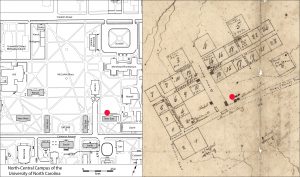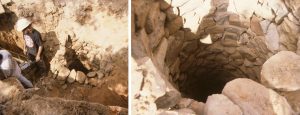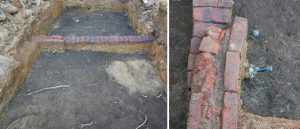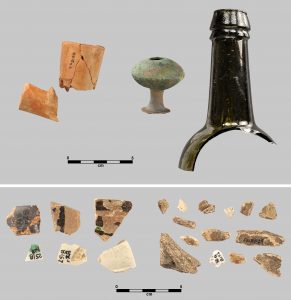The New East Site

The New East site contains archaeological remains associated with Steward’s Hall, one of the first buildings on campus. It was constructed in 1794 and served as the University Commons, or dining hall, until 1816. Steward’s Hall was a small, wood-frame house that measured 30 feet by 36 feet and had two chimneys. An early nineteenth-century map of the campus indicates that smaller buildings were located just to the north. According to students’ letters home, the facility was notorious for meals and service that were both equally bad. After 1816, the building was used as a private boarding house until its dismantlement in 1847. Steward’s Hall was located immediately south of where New East, built in 1858, now stands.
In an address in 1883 on the history of the University of North Carolina campus, President Kemp P. Battle described the building’s location, its role in the university’s system of room and board, and the extracurricular events that took place there.

“The Steward’s Hall was situate nearly opposite the New East Building in the centre of Cameron Avenue. It was there that most of the students for many years boarded at Commons, paying for the first year $30, or $3 per month, for the next four years $40 per year or $4 per month, in 1800 rising to $57 per year, in 1805 to $60, in 1814, under the inflated war prices to $66.50, in 1818 to $95, or $9.50 per month, in 1839 to $76, when the system was abandoned and every man made his own contracts for the supplies of life. It was in this building that the ‘Balls’ of the old days were given, at which tradition hath it, venerable Trustees and Faculty, even the great President himself, together with their pupils, with hair powdered and plaited into ‘pigtails,’ and legs encased in tight stockings and knees resplendent with buckles, mingled in the mazy dance with the beauteous damsels of the day, whose brilliant dresses and angelic beauty far be it from me to describe.”

Investigations have failed to determine the exact location of Steward’s Hall; however, two archaeological contexts were found that likely are associated with the elusive building. Both discoveries resulted from monitoring by UNC archaeologists of construction activities to modernize campus infrastructure. In 1995 an abandoned well was discovered by a construction crew laying fiber-optic cable along the north side of Cameron Avenue. The open well was lined with undressed stone and had been covered with pieces of railroad track laid side-by-side. It had been dug more than 40 feet into the Chapel Hill clay (see photos at right).

The second context likely associated with Steward’s Hall was a buried layer of soil, or midden, that contained numerous artifacts from the early nineteenth-century midden. It was found in 2007 during archaeological testing ahead of utility line installation immediately north of New East. This midden likely formed as discarded trash accumulated in the backyard of Steward’s Hall. As can be seen in the photos (at right), the deposit is uniformly capped by a thick layer of yellow clay. This clay probably was deposited here when the foundations for New East were dug in the 1850s. An investigation of the crawlspace beneath New East revealed that the original foundations for both the exterior and interior walls consisted of large stones dry laid in hand-dug trenches.

While no artifacts were recovered from the well, the midden contained fragments of pottery, tobacco pipes, pieces of glass bottles and tableware, charcoal, oyster shell, animal bone, and a brass doorknob. These artifacts represent refuse discarded in the backyard of Steward’s Hall and some, such as the doorknob, likely were deposited there when the building was demolished. Artifacts in the photo (at right) include a clay pipe, doorknob, wine bottle neck, pottery fragments, and animal bone fragments.
Contributor
R. P. Stephen Davis, Jr. (Research Laboratories of Archaeology, University of North Carolina, Chapel Hill)
*Images courtesy of the Research Laboratories of Archaeology, University of North Carolina, Chapel Hill.
Source
Davis, R. P. Stephen, Jr.
2015 • The Hidden Campus: Archaeological Glimpses of UNC in the Nineteenth Century. Gladys Hall Coates University History Lecture, Wilson Library, University of North Carolina, Chapel Hill, April 14, 2015.
